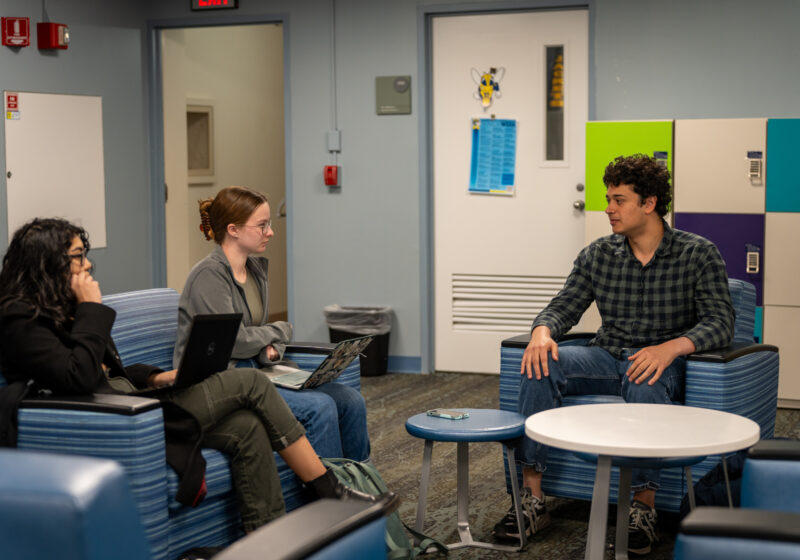Two UR students participating in different study abroad programs share their unique experiences while living in Italy during this historical time.
On April 7, I dropped everything and boarded the first train to Rome. I hoped to arrive before authorities closed the line, but time was against me. Upon arriving at Roma Termini, I sprinted to the first bus that would put me at the head of the line. I joined the line at 9:30 p.m. with only half an hour to spare. Authorities were scheduled to close the line at 10 p.m.All seemed poised for the long wait. I was one out of one million people in line at that moment. Everyone had the same goal – a brief glimpse at the body of Pope John Paul II lying in state. Current estimates are hovering around 12 hours of wait time. Everyone is prepared with backpacks, containing snacks and water. Comfortable shoes and warm clothes are a must.For the first few hours, the mood is festive. The people are singing in their native tongues and waving flags that display their nationality. The crowd begins to chant “Giovanni Paolo!” Some display banners thanking the deceased pontiff for 26 years of service to the world.Truck loads of Italy’s military police, Carabinieri, rush up and down the streets. A Carabinieri helicopter circles the area, keeping an eye on the situation. The line crawls along the bank of the Tiber River. In the first two and a half hours, a respectable 500-meters of progress were made, about half the distance to Saint Peter’s Basilica. However, the progress grounded to a near standstill once I turned the corner. The next few hours would be spent on the bridge dedicated to Vittorio Emmanuelle. The line had swelled from five to 50 people wide.Four hours into the wait, the enthusiasm has begun to fade. It is now 1:42 a.m., and we have almost finished crossing the Tiber River. I look around, but there are bodies in every direction. The crowd never knows when authorities will allow the line to move again, but they knew that it would only be a few steps. People are packed so tightly that only a few can sit down at a time, quickly crowding out all other space available for students. The energy begins to grow again at 2:03 a.m. Italians are singing popular songs and chanting to the pope again. Every 10 minutes or so, an ambulance forces its way through the width of the entire crowd. It is rushing another person to the hospital who fainted from exhaustion. At 2:58 a.m., a Polish girl to my left faints. The crowed pulls away, forming a circle around her body, which lies lifeless on the pavement. Medical staff is signalled and forces their way to the scene. She is removed from the crowd, treated and re-inserted back into the line.At 6 a.m., I have made my final turn and am on a straight approach to the Basilica. My current progress is about 50 meters an hour. The line is the entire width of the street. The energy remains high, and the Polish flags in every direction never cease to wave.The sun begins to rise on the crowd’s backs. The crowd becomes anxious, but is calmed by the multi-lingual propaganda being read over the Vatican loudspeakers. The crowd is able to watch gigantic television screens that display live images from the inside of Saint Peter’s Basilica.At 8:21 a.m., I have entered the Piazza. Our group lets out cheers of relief. Although I am now in the Vatican state, my wait has not yet concluded. Street cleaning machines and Vatican officials rush about cleaning up the massive amount of litter dragged along by the crowd.Finally, I pass through the red curtains hanging at the entrance at the Basilica. The time is 9:30 a.m. People fall silent as they enter the nave for the final approach. All are pensive, melancholy and reverent. A cantor sings medieval hymns in a solemn mood.As I near the papal altar, my emotions overwhelm me. After an over 12-hour wait, I can finally spot the body of the deceased pontiff. He is lying on a pedestal tilted up slightly toward his head. Four Swiss Guards surround him, wearing brightly coloured costumes and armed with traditional medieval pikes.Upon reaching the front of the line, I am astonished. He lies with complete honour, however his mortality is evident. This does not seem like one of the greatest figures of our time, but a small, frail man. I lift the camera to my face.I have never felt more stressed while taking photos. The moment was critical. Upon reaching the front of the line, the Vatican officials told us, “That’s enough. Prego. Move along.” I continuously snap photos while adjusting composition and focus, all while being forced along to the side. Twice I lower the camera from my eye to gaze upon the pope with my own eyes. In about 15 seconds, it is over. I am ejected to the left side and can no longer see the pope. The experience was incredible, unlike any I had experienced so far. I linger around in shock and awe for a few minutes. However, one last treat awaits me. Once I am back in the square, we see piles of various items left behind – the flags, mostly Italian and Polish, letters addressed to the Pope thanking him and candles. The whole block has been turned in to a temporary memorial. One can read the stories of thousands he has touched. I take some pictures, but I do not look. The emotion is simply too much for me to handle. I collapse onto the curb. I am emotionally drained. Despite my exhaustion, I am satisfied. It was worth the wait.Slominski can be reached at aslominski@campustimes.org.

